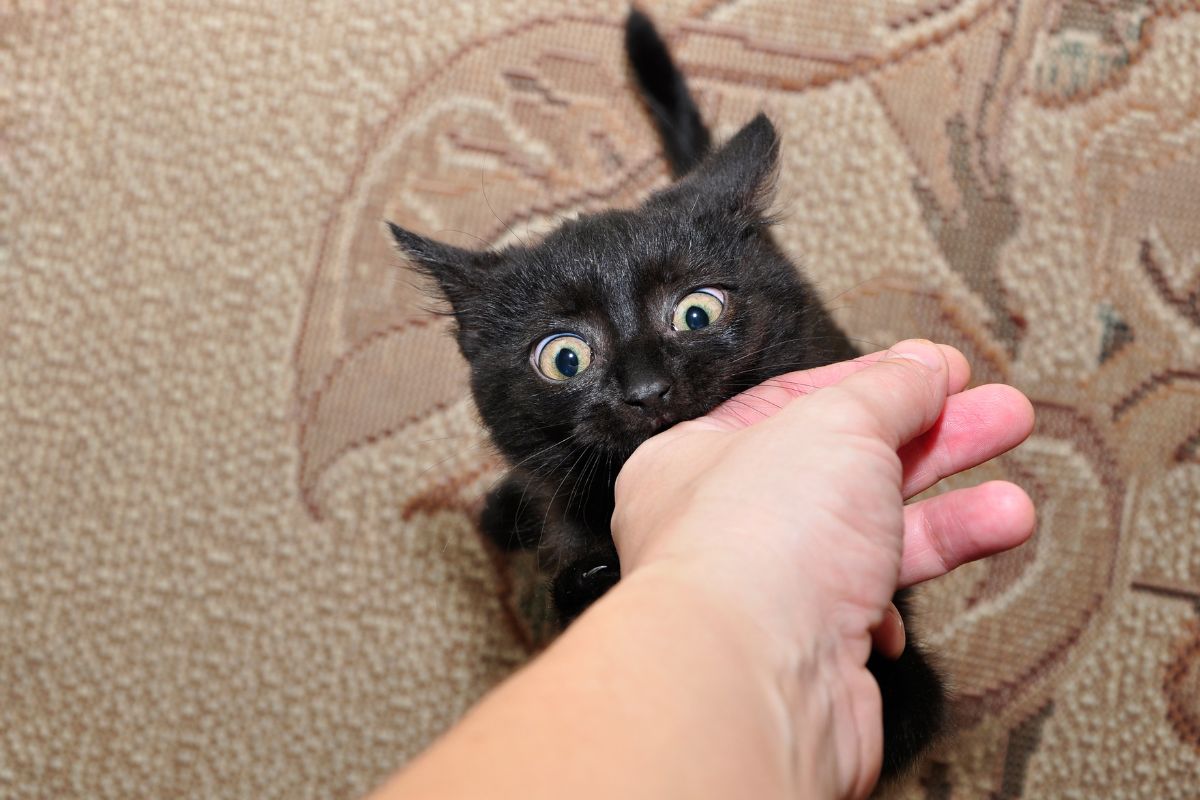Show table of content Hide table of content
Cats often baffle their owners with seemingly contradictory behaviors. One moment they’re purring contentedly during a petting session, and the next, they’re nibbling on your hand. This behavior, while startling, carries important messages about your feline’s boundaries and comfort levels.
Decoding your cat’s nibbling behavior
When your cat suddenly nips during a belly rub, they’re not being aggressive—they’re communicating. According to animal behaviorist Adam Tordjmann, these little bites serve as a clear signal that your petting has crossed a comfort threshold. Cat skin contains numerous sensitive nerve endings, making repetitive strokes potentially irritating or even painful for some felines.
These communicative nibbles typically occur when touching sensitive areas like the belly, tail, paws, and sometimes even the head. Many cat owners misinterpret these gentle bites as playful behavior, but they actually represent your cat’s way of saying “enough.” Understanding this distinction helps build trust with your feline companion.
Cats display remarkable restraint when communicating discomfort. They could easily draw blood with their sharp teeth, but instead choose a gentle warning nip. This restraint demonstrates the sophisticated communication system cats have developed to interact with humans. Feline behavior experts note that this nibbling behavior is instinctual and not something cats can easily suppress or modify.
This communication method isn’t limited to domestic cats. Similar behaviors appear in feline-canine interactions where boundaries need establishing. These cross-species communications highlight how universal and instinctive these warning signals are among mammals.
Warning signs before the nibble
Observant cat owners can detect several precursors to the nibbling response. Your cat typically displays subtle signals before resorting to a warning bite. Stopping purring abruptly signals a shift in mood, while licking or pushing away your hand represents direct intervention attempts. More obvious signs include ears flattening backward, pupil changes (either dilating or contracting), and tail twitching or lashing movements.
These signals represent your cat’s first attempts at communication. By recognizing these early warnings, you can respect your pet’s boundaries before the situation escalates to nibbling. Tordjmann emphasizes that observing these cues helps strengthen the bond between cats and their human companions. The most successful cat owners develop an intuitive understanding of their pet’s body language.
Cat A 12-year-old cat survives a dizzying 377-foot fall into a canyon.
During winter months, cats may show increased sensitivity, especially those rescued from harsh weather conditions. Cold temperatures can heighten nerve sensitivity, making normally tolerable touching uncomfortable. Similarly, cats in new environments may exhibit heightened nibbling behaviors as they adjust to unfamiliar surroundings.
Unlike dogs who typically tolerate handling even when uncomfortable, cats prioritize bodily autonomy. This fundamental difference in pet temperament explains why dogs rarely exhibit similar warning bites during petting. While abandoned puppies might seek any human contact, cats maintain stronger boundaries regardless of their background.
Preferred petting zones and techniques
Most cats have specific areas they enjoy being touched and others they consider off-limits. The back and under the chin typically rank as favorite spots, while the belly often proves problematic despite its apparent invitation. The stomach area represents a vulnerable region for cats, making many felines instinctively protective of this area even when relaxed.
Effective petting involves reading your cat’s responses and adjusting accordingly. Short, gentle strokes generally work better than long, repetitive motions. Starting with limited contact then gradually increasing duration based on your cat’s comfort level builds positive associations with handling. Some cats who initially dislike belly rubs can gradually accept them when introduced slowly and respectfully.
Cats rescued from difficult situations, like those saved from dangerous environments, may need extra patience when establishing touching boundaries. Their past experiences often influence their comfort with human handling. Professional animal behaviorists recommend gradual desensitization techniques for these cases.
Interestingly, many cats display petting-induced aggression—a condition where pleasurable petting suddenly becomes overstimulating, triggering the nibbling response. This phenomenon explains why cats sometimes bite even during seemingly enjoyable interactions. The threshold varies dramatically between individual cats, with some tolerating extended touching and others reaching their limit quickly.
Health concerns behind excessive nibbling
While occasional nibbling represents normal feline communication, excessive biting might indicate underlying problems. According to International Cat Care, dental pain, digestive issues, or stress can manifest through increased sensitivity to touch. Cats experiencing these problems may bite more frequently or with less provocation than usual.
Environmental stressors significantly impact feline behavior. Loud noises, household changes, or the introduction of new pets can trigger anxiety-related nibbling. Cats process stress differently than dogs, who might react to trauma through vocalization or destructive behaviors rather than increased biting.
Veterinary assessment remains essential when nibbling behavior changes suddenly. Professional examination can identify medical issues requiring treatment. Some cats experience hypersensitivity due to neurological conditions that magnify sensory input, making normal petting uncomfortable.
Maternal instincts also influence nibbling behaviors. Female cats with maternal experience often display protective tendencies similar to mother dogs protecting their puppies. This protective instinct can manifest as increased sensitivity to handling around the stomach area, even years after having kittens.
Respecting your cat’s communication represents the cornerstone of a healthy relationship. Rather than punishing nibbling behavior, recognize it as valuable feedback about your interaction. By honoring these boundaries, you demonstrate respect for your cat’s unique personality and needs. This mutual understanding forms the foundation for a trusting, harmonious relationship with your feline companion.


